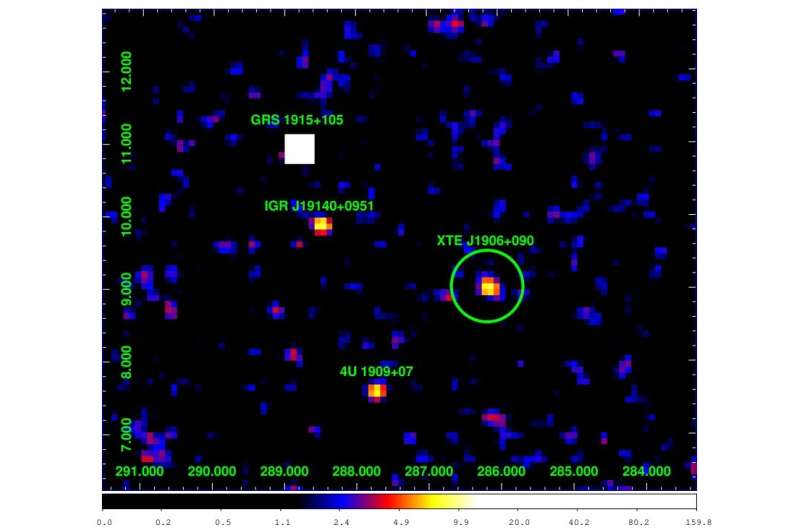May 18, 2023 report
This article has been reviewed according to Science X's editorial process and policies. Editors have highlighted the following attributes while ensuring the content's credibility:
fact-checked
preprint
trusted source
proofread
XTE J1906+090 is a persistent low-luminosity Be X-ray binary, study suggests

Using INTEGRAL and Swift spacecraft, European astronomers have observed an unidentified X-ray source known as XTE J1906+090. Results of the observational campaign, presented May 11 on the arXiv preprint server, suggest that this source belongs to the small and rare group of persistent low-luminosity Be X-ray binaries.
X-ray binaries are composed of a normal star or a white dwarf transferring mass onto a compact neutron star or a black hole. Based on the mass of the companion star, astronomers divide them into low-mass X-ray binaries (LMXB) and high-mass X-ray binaries (HMXB).
Of special interest are Be/X-ray binaries (BeXRBs), a subclass of HMXBs in which the optical star is a dwarf, subgiant or giant OBe star. Studying X-ray outbursts from BeXRBs could be essential in order to improve our understanding of the nature of X-ray binaries and their behavior.
XTE J1906+090 was first detected in 1996 with the Rossi X-ray Timing Explorer (RXTE) spacecraft and initially classified as an unidentified transient X-ray pulsar with a spin period of about 89 seconds. Previous studies of XTE J1906+090 have suggested that it may be a BeXRB system at a distance of some 33,000 light years, however due to the lack of optical and infrared spectroscopy, it was difficult to confirm this.
Now, based on the data from the INTErnational Gamma-Ray Astrophysics Laboratory (INTEGRAL) and from the Neil Gehrels Swift Observatory, a team of astronomers led by Vito Sguera of the Astrophysics and Space Science Observatory of Bologna, Italy, has provided further evidence supporting the BeXRB scenario for XTE J1906+090.
According to the study, XTE J1906+090 has been consistently detected by Swift at a persistent low X-ray luminosity value of about 10 to 40 decillion erg/s, with limited variability. Therefore, the X-ray characteristics of this source, together with its long spin period, strongly resemble those of persistent low-luminosity BeXRBs, which are a small and rare subgroup of peculiar BeXRBs.
"Such properties suggest that the compact object orbits the donor Be star in a wide (orbital periods longer than ∼ 30 days) and nearly circular (e<0.2) orbit, rarely or never crossing the decretion disk star and continuously accreting material from the lower density outer regions of the stellar wind," the researchers explained.
The observations also detected four X-ray outbursts of XTE J1906+090 characterized by a similar X-ray luminosity of about 1,000 decillion erg/s. The astronomers noted that similar sporadic variability has been already observed in all the BeXRBs which are traditionally considered as persistent sources.
Moreover, the researchers found that the maximum to minimum luminosity ratio of XTE J1906+090 is fully consistent with that observed in most of the persistent BeXRBs. However, they added that much deeper X-ray spectral investigation of this source is needed in order to draw final conclusions regarding its nature.
More information: V. Sguera et al, XTE J1906+090: a persistent low luminosity Be X-ray Binary, arXiv (2023). DOI: 10.48550/arxiv.2305.06689
Journal information: arXiv
© 2023 Science X Network





















